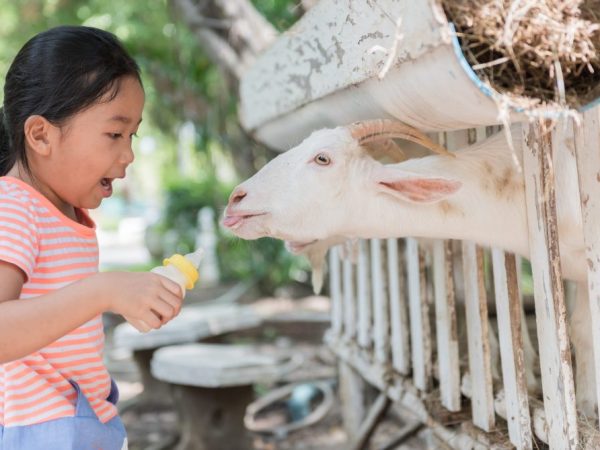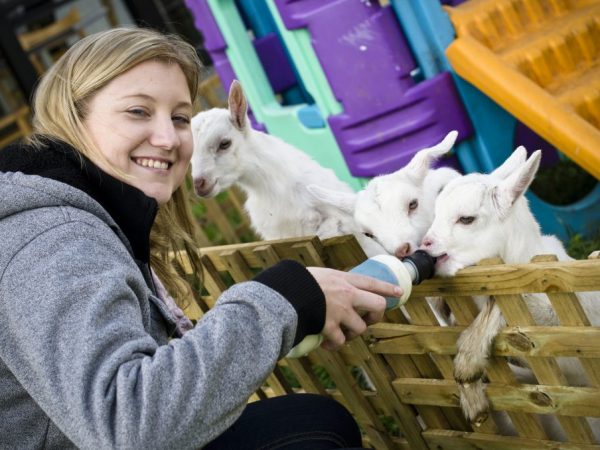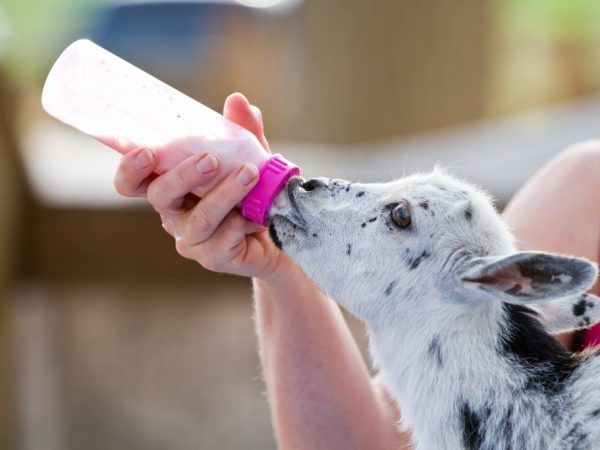How can you feed a goat immediately after lambing and what complementary food to give to newborn kids
For any living organism, pregnancy is a heavy load, and goats are no exception to this rule. Many farmers are wondering - what to feed the goat after lambing? The fact is that artiodactyls eat an exceptionally dry diet during pregnancy, while after childbirth they need a large supply of vitamins to replenish immune cells.

Goat feed after lambing
The animal's reproductive system also requires restoration. Remember, balanced feeding of the goat after lambing is the key to healthy kids and mother.
Goat diet before lambing
Changing the diet after giving birth will not help the goat recover if the female ate improperly during pregnancy. The last two months have given the greatest load on the body of a cloven-hoofed animal. The kids grow and develop rapidly, drawing energy and nutrients from the mother's body.
A deficiency of nutritious food can have a bad effect on the female - the body will replace the lack of internal resources. Subcutaneous fats, muscles and bone tissue will be used. Internal organs such as the stomach and kidneys may be disrupted. The liver will not cope with the intoxication of the body. Poor functioning of the mammary glands is noted. If the goat is too emaciated, the risk of miscarriage or the birth of weak cubs is greatly increased.
The diet of a pregnant artiodactyl should contain a large amount of concentrated feed. Moreover, the daily rate rises every day - in the third month, the goat should consume 100-150 grams per day, and at the end of pregnancy the figure reaches half a kilogram. Concentrates are best for oats, barley, wheat and corn. It is better to crush or crush crops. It is better to exfoliate barley before starting feeding, otherwise the gastrointestinal tract can be clogged.
During pregnancy, the female should not be given:
- juicy feed containing high acidity and oiliness;
- root vegetables in an amount of more than a kilogram per day;
- beer tremors;
- straw and hay of poor quality.
Silage and root vegetables are given in limited quantities due to their effect on the mammary glands of the goat. In addition, the exceeded intake of these products leads to ketosis - an unpleasant disease that disrupts the metabolism of artiodactyls. Pregnant individuals are especially susceptible to this disease.
Straw has a low nutritional value, and the goat will have to eat a lot of this product to relieve hunger. However, the stomach of a pregnant female is not intended for a large amount of food - during pregnancy, the uterus experiences the digestive organs.
You should not overfeed a pregnant goat either - obesity can greatly complicate the process of childbirth. The female will not be capable of intense labor, and the kids may suffocate during lambing. Also, weight above normal can lead to complications after childbirth - prolapse of the uterus, mastitis and retention of the placenta.
Feeding goats after lambing

Babies and a goat need care
Childbirth in artiodactyls lasts two to three hours, sometimes it can drag on for a longer period. At this time, the animal is experiencing intense stress on the body, which must be compensated in full. The appearance of goats into the world requires a lot of energy.
However, postpartum stress prevents the goat from starting to eat normally. Feeding the goats after lambing can be a major problem for the farmer. The balanced and nutritious nutrition of the mother goat after lambing is not only a guarantee of her health, but also a factor that affects the well-being of the offspring. First of all, the animal should be watered - lamb can cause a strong thirst in the female. It is best to use amniotic fluid to help the goat restore its internal reproductive environment. This will speed up the discharge of the placenta and help the uterus to regain its previous shape.
On the first day after giving birth, the goat does not require enhanced nutrition. To replenish the animal's vital energy, good hay from cereal and leguminous herbs is enough. You can make a wet mixture of bran and finely crushed root crops - such a complementary food will be to the taste of the new mother. Concentrated and juicy feed can be given, but in limited quantities - no more than fifty percent of the daily requirement.
On the first day after lambing, high quality hay from cereals is enough for the animal. Concentrated and juicy feeds can be given, but in limited quantities - no more than 50% of the usual rate.
A balanced diet for a goat after lambing looks like this:
- Hay from a mixture of various herbs - 3 kilograms.
- Grated barley and oats - 200 grams.
- Chopped root vegetables - 1 kilogram.
- Cereal bran - 100 grams.
For better assimilation of feed, sugar, vitamin supplements containing glucose or sugar beets can be mixed into the animal's water.
These components help to normalize the functioning of the female's internal organs, accelerating the process of body recovery. In some cases, veterinarians recommend administering glucose intramuscularly. Also, do not forget about other important elements for life - for example, calcium. After pregnancy, the body of a goat, as a rule, is depleted, since for a long time it has provided for itself and the young, so the animal may experience postpartum fever. To avoid this, the goat is injected with calcium chloride. It is also worth adding bone meal, chalk and fish oil, which contain vitamin D, to complementary foods.
The veterinarian may also prescribe injections if the goat continues to refuse food after lambing. An animal weighing fifty kilograms can be administered up to 500 milliliters of five percent glucose per day. If you are injecting calcium yourself, be extremely careful. If the medication is injected subcutaneously, inflammation and necrosis may begin. To increase appetite and improve the functioning of the gastrointestinal tract, hellebore solution should be injected through the larynx. Tympanol is also effective in replenishing nutrients in the body.
Fattening to increase milk production

Little kids drink mother's milk
Immediately after childbirth, the milk yield of the goat rises rapidly. The first milking should be done half an hour after lambing. If the goal of breeding goats is milk, then farmers often practice early dropping the kids from their mothers. Thus, the owners get the maximum milk yield for sale. If the main products of the farm are wool and down, then the offspring are left with the female, but in this case, the diet must be balanced so that the kids grow up healthy and develop faster.
In the first three months, the lactation of the goat increases every day or remains stable at a high level.
At this time, the so-called advance feeding should be introduced. This technology has gained particular popularity among pastoralists. The idea behind this feeding method is to give the animal more food than is required.During increased milk yield, females are extremely sensitive to energy loss and will accept improved housing conditions favorably.
Advance feeding is mandatory for dairy goat breeds, even outside the lambing period. The organism of these artiodactyls is aimed at producing a large milk yield, which can greatly harm the female without feeding.
The daily diet of a goat after lambing to increase milk production looks like this:
- barley - twenty percent of the daily value;
- oats - twenty percent of the daily value;
- corn - ten percent of the daily value;
- wheat and bran - fifteen percent of the daily value;
- yeast, herbal flour and permix - fifteen percent of the daily value.
From this list, we can conclude that concentrates should be in the first place in feeding a goat after lambing. From these concentrates, you can make a compound feed to increase milk production in goats. In the first week, the daily rate is 300-400 grams of such a mixture. Then the rate is increased by 100 grams every week until the milk yield stabilizes. After reducing the lactation level, the goat's diet should also be made more dietary, otherwise there is a risk of obesity.
To improve milk yield, you also need to use succulent feed. You can give from three to five kilograms of silage per day. This type of feed has a high calorie content, and due to its high water content, it increases the lactation of the animal. Check the food you give the goat - spoiled or sour silage can cause poisoning and harm not only cloven-hoofed animals, but also the young.
Only the highest quality hay is given to lactating females. Cereals and legumes are best suited. The animal eats three kilograms of hay per day. If lambing occurs in winter, prepare the required amount in advance. Straw is not recommended for the goat as its nutritional value is very low.
But, as a last resort, you can grind and steam the cereal straw, and then mix it with yeast. This will increase the calorie content of the feed and make the straw easier for the goat to digest. Sometimes farmers soak the straw in salted water or lime to increase the animal's mineral levels.
The diet of lactating females is different from that of the usual and should be balanced. Protein, minerals and vitamins are valued in feed for lambing goats. The lion's share of nutrition is concentrated feed, but they will not be enough to fully compensate for the lack of vitamins and minerals. For this, juicy feed and premixes are used.
How to feed little kids
One of the first questions that worries a farmer who has received offspring from a goat is how to feed the kids after lambing? In the first month, kids eat at least five times a day, every four to five hours. It is advisable to leave the cubs next to the mother for the first few months. However, this will significantly reduce the daily milk yield. Therefore, many farmers carry out procedures for the early weaning of kids from their mothers.
Lactating goats are not milked well because more milk goes to the kids.
If the farm is meat-oriented, the cubs are left with their mother for up to five months. Only in the fourth month they begin to enter the usual food. Remember that in winter, the animal's diet should be more nutritious than in summer, and without the daily ration of milk, the kids may die. Also, the kids need to be given mineral supplements. This usually begins in the third week after birth. The daily intake of salts and minerals is ten grams per calf.
Young animals should be released together with adults after the first month of their life. By this time, the immunity of the cubs will have finally become stronger, and they will be able to receive good food in the form of fresh grass. The kids are weaned from milk gradually at about the third month. From this moment on, you can already take most of the milk yield for sale.
Conclusion
How to properly feed a kid after lambing? We remember that he, like the newly-born mother, needs a balanced and rich menu and proper feeding. And the first "dish" will be "mother's" milk. If the kid was weaned from the mother, then it should be fed with the same milk. For this, milk is heated to milk temperature. It should not float or burn the baby.
Young kids at the age of seven to eight months are already actively eating up hay and mixed feed. Increase the daily ration of silage in the kids' diet every day. Potatoes, carrots and cabbage are sources of essential vitamins for a growing body. Beets should be introduced into the diet carefully - this natural laxative can lead to upsetting the stomachs of young animals that are not yet strong. Before complete weaning, the kid is completely transferred to the "adult" menu. A balanced diet will allow the kids to grow as much as possible by the first year of life.


